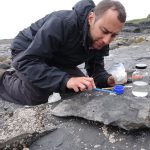You’ve probably seen that advert put out by the National Museum of Scotland, to woo dinosaur enthusiasts to the limited-time-only Tyrannosaurs exhibition. A fluffy, Mohican-crested dinosaur gets off a flight at Edinburgh airport, rushes onto a tram, and scrambles through the Old Town, before arriving at the exhibit just in time.
It’s an ingenious advert, which earned every social media click as it went viral a few weeks ago. But something’s missing. The little human-sized tyrannosaur—a species called Guanlong—should have stopped at my lab at the University of Edinburgh first. That’s because one of its cousins lives there, another primitive tyrannosaur species called Timurlengia. A few years back my colleagues and I described Timurlengia as a new species of horse-sized, big-brained, T. rex antecedent. It’s one of many new species of tyrannosaur that I’ve studied and named over the past decade, as my group at the University has become established as a leading centre of tyrannosaur research.
Over the last decade or so, my colleagues and I have discovered new tyrannosaur fossils, worked on building their family tree, and studied their evolution. We’ve shown how the tyrannosaur group is an ancient line that went back at least 100 million years before the mighty T. rex ruled the latest Cretaceous with its bus-sized frame and bone-crunching jaws. The earliest tyrannosaurs were animals like Guanlong, no bigger than us. Then intermediate-sized species like Timurlengia came along, about the size of a horse or jeep, evolving big brains and keen senses to survive in the shadows of other giant predatory dinosaurs. And only at the very end of the Cretaceous, when these competitor dinosaurs went extinct, did the giants like T. rex rise to the top of the food chain.
As a tyrannosaur researcher, it gives me such a thrill to see the Tyrannosaurs exhibition come to Edinburgh. The exhibit features some of my research and discoveries, and I helped consult on it when it was designed by the Australian Museum a few years ago. It’s a stunning exhibit and it tells the story of tyrannosaur evolution in a way that no blog posts or books can. By seeing all of these skeletons, side-by-side, you can really fathom how tyrannosaurs started humble, bided their time, and then took over the world.
I’ll be talking more about this story at the Museum Late: Jurassic Party on the evening of Friday March 13. Please come along then to hear all about my adventures digging up and studying tyrannosaurs. And as I’m contractually obliged to do, I’ll be signing copies of my recent pop science book The Rise and Fall of the Dinosaurs. A book which, by the way, devotes two entire chapters to tyrannosaurs, much to the chagrin of some reviewers who wanted to see less gore and more attention on the plant-eating dinosaurs. I’m happy with the decision I made, and I think you’ll understand why when you see the glory of tyrannosaurs in this exhibition.
Steve’s 2018 book The Rise and Fall of the Dinosaurs, which tells the story of dinosaur evolution and the people who study dinosaurs, was a Sunday Times bestseller, named the Science Book of the Year by the Times, and won the Goodreads Choice Award for Best Science and Technology Book.
